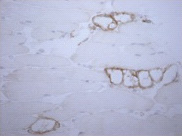Aoc3 Rat Monoclonal Antibody [Clone ID: 7-88]
Specifications
| Product Data | |
| Clone Name | 7-88 |
| Applications | FN, IF, IHC, IP |
| Recommended Dilution | Immunohistochemistry on Frozen Sections (Ref.2,3): Tissue sections were fixed in acetone and incubated with antibody 7-88 for 20 minutes at room temperature. As negative control an irrelevant isotype-matched antibody was used (Ref.2). Flow Cytometry: Stains the extracellular domain of mouse VAP-1 in CHO cells transfected with mouse VAP-1 cDNA. As positive control anti-VAP-1 clone 7-106 was used and as negative control an isotype-matched control antibody (Ref. 2). Functional Assays (Ref.2,4): Antibody 7-88 (200µg) was intravenously injected which resulted in the inhibition of leukocyte trafficking in inflamed peritoneum (Ref.2). Immunofluorescence (Ref.5). Immunoprecipitation (Ref.1). Positive Control: Mouse VAP-1-transfected CHO cells (Ref.2). Negative Control: Mock-transfected CHO cells (Ref.2). |
| Reactivities | Mouse |
| Host | Rat |
| Isotype | IgG2b |
| Clonality | Monoclonal |
| Immunogen | Vessels from mouse lymph nodes |
| Specificity | The monoclonal antibody 7-88 recognizes mouse Vascular Adhesion Protein-1 (VAP-1) which is a glycosylated homodimeric membrane protein consisting of two 90 kDa subunits connected by disulfide bonds. It inhibits migration of granulocytes and monocytes in acute models of inflammation. |
| Formulation | PBS State: Purified State: Liquid 0.2 µm filtered Ig fraction Stabilizer: 0.1% BSA |
| Concentration | 0.1 mg/ml |
| Purification | Protein G Chromatography |
| Database Link | |
| Background | VAP-1 is a glycosylated homodimeric membrane protein consisting of two 90 kDa subunits connected by disulfide bonds. It contains a short N-terminal cytoplasmic tail, a single membrane-spanning domain and a large extracellular part. A soluble form of VAP-1 (sVAP-1) has been described, which presumably results from the proteolytic cleavage of membrane-bound VAP-1. Structurally VAP-1 belongs to enzymes called semicarbamizide-sensitive amine oxidases, which contain copper as a cofactor. These enzymes deaminate primary amines in a reaction producing hydrogen peroxide, aldehyde, and ammonia. |
| Synonyms | HPAO |
| Reference Data | |
Documents
| Product Manuals |
| FAQs |
| SDS |
{0} Product Review(s)
Be the first one to submit a review






























































































































































































































































 Germany
Germany
 Japan
Japan
 United Kingdom
United Kingdom
 China
China



